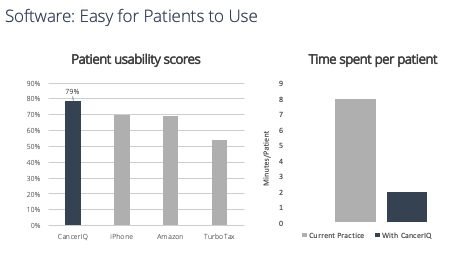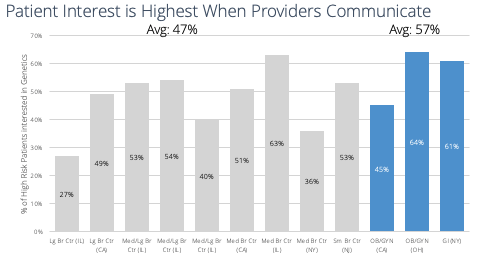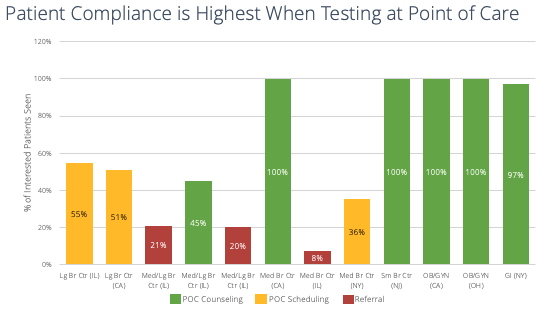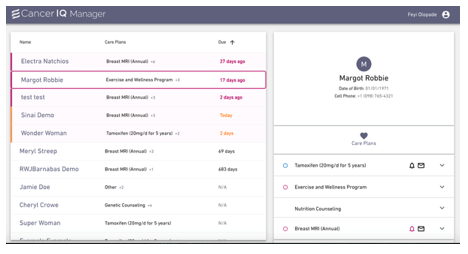Genetic counseling and testing has become the standard of care in cancer centers today. With genetic services becoming mainstream in healthcare, CancerIQ CEO Feyi Olopade Ayodele was invited to speak at the Association of Cancer Executives 2020 Annual meeting on the topic.
In the best practices workshop, Feyi shared how cancer centers can improve their patient access to genetic services by implementing cancer risk assessment software. As someone providing care in a cancer center, you need an efficient genetic counseling and testing process to meet the standard of care for your patients.
In this post, we'll share key takeaways from the best practices workshop and how implementing cancer risk assessment software has helped multiple health systems maximize the value of their genetic counseling, testing, and high-risk management systems, specifically:
- How to navigate your patients to genetics
- How to increase your genetic service capacity
- How to manage your patients
Navigating Patients to Genetic Services
Your cancer center's risk assessment program will not be successful if you do not do the first steps correctly - screening and navigating patients. By implementing software, changing referral patterns, and communicating effectively, you can increase utilization of your high-risk services from the start.
Screening Patients
Challenges
Many cancer centers today are still using paper forms to identify eligible patients for genetic services. Using paper forms is a simple process, but leads to challenges such as:
- Difficulty staying in accordance with complex ever-changing guidelines
- Provider stress associated with interpreting a complex form
- Lower patient accuracy in reporting information
Some cancer centers have turned to Electronic Health Records (EHR's) to screen patients, but have faced limitations such as:
- Few vendors offer access to clinical guidelines
- Provider stress associated with interpreting complex form
- Time constraint due to manual data entry
Switching to Software
While these challenges can be intimidating, implementing cancer risk assessment software allows you to overcome these obstacles by:
- Patient ease of use
- Providers ease of interpretation with real time decision support
- Updates with ever-changing guidelines
Impact
Switching from paper to software helped Riverside Healthcare streamline their screening process. After switching to CancerIQ, Riverside reported:
- Improved patient comprehension of screening forms
- Reduced staff stress with easy to identify text
- 2.5x more high-risk patients identified
Navigating Patients
While effectively screening is patients is crucial to success, getting the patients from point A to point B is even more impactful. We've seen success with providers who follow these patient communications tips and find the right implementation model.
Communication Tips
1. Get Providers Involved
We've found patient interest in genetics is highest when providers communicate with the patient. Although the patient main interactions at this time in the process are with the front desk and nurse navigators, using software allows you to customize your screening form with an intro video from the provider.
2. Use Positive Words when Speaking of Risk
Patients tend to be apprehensive and less likely to use your genetic services when told things such as, "You are at high risk for cancer and should see a genetic specialist," or,"You might want to consider calling the genetics department."
Instead it is important to be positive and direct with patients. For example, "You are eligible for a cancer prevention consultation," or," You are eligible for something more personalized, above and beyond a mammogram," will lead to higher utilization of your genetic services
3. Use Feedback to Improve Provider-Patient Communication
To fully enhance your cancer centers process, its best to incorporate feedback on what's working and what's not. Using risk assessment software allows you to track and measure patient interest in genetics - including decline reasons - and fully optimize your communication approach.
Implementation Models
There are three main implementation models for cancer risk assessment software; Point of Care Counseling, Point of Care Testing, and by Referral. We covered each model in depth in a recent post.
Finding the optimal implementation model for your cancer center is important, but we've seen the most success with health systems using the point of care counseling model, because patient compliance is highest when using the point of care counseling model.
Impact
UW Medicine is a prime example of this success, as they were able to implement these communication tips in a point of care counseling setting. After implementing cancer risk assessment software, they reported:
- Ability to identify gaps in performance leading to changes in communication techniques
- Increased patient interest rates after using communication tips
- 4x increase in enrollment in high-risk clinic
Increasing Genetic Service Capacity
When your cancer center is increasing the number of eligible patients, you need to increase your genetic service capacity without creating staff burnout. Increasing your genetic service capacity without staff burnout is a key to your cancer center's risk assessment programs success.
Challenges
While genetic specialists know how to prevent cancer, sometimes the process is time consuming and costly. For example, genetic specialists face challenges such as:
- Long appointment times
- Burdens from administrative work
- Complex workflows
Switching to Software
Using cancer risk assessment software eases the burden of these challenges by streamlining the cancer risk assessment process in the following ways:
- Reduced appointment times
- Pre-populated testing and insurance forms
- Standardized process for risk assessment
Impact
We've seen many health systems incorporate risk assessment software to increase genetic service capacity without hiring additional staff. For example, Advocate Aurora, a health system in Wisconsin, cut appointment times by more than half, allowing them to serve 6 more patients per week.
Managing High-Risk Patients
Screening and testing are crucial to your cancer centers success, but the greatest impact on your cancer center comes in managing patients at high-risk for cancer. Effectively managing patients leads to higher downstream revenues and healthier patient populations.
Challenges
However, cancer centers also face challenges in patient management including:
- Inability to provide patient follow-up
- Low patient compliance to recommendations
- Inability to prove impact of genetic services
Patient Management
These obstacles combine to create a loss in downstream revenues, but can be overcome with cancer risk assessment software allowing your cancer center to maximize the clinical and financial value of genetics in your health system.
Cancer risk assessment software allows providers to determine which patients need active management, see alerts of patients who require follow-up, and send email reminders to patients at risk.
Impact
CHRISTUS Oschner Lake Area Hospital improved their profitability and patient retention by using CancerIQ. They saw the following benefits after incorporating digital cancer risk assessment software:
- Increased provider and patient satisfaction
- Short term revenue increase due to medical management changes
- Insight into downstream revenues for risk assessment program
Looking Forward
While we love to see the success of health systems mentioned above, there is still work to do in achieving healthier populations with early detection.
In the full session, Feyi goes on to speak on financial considerations and how to ensure buy-in from leadership.
You can access the entire presentation video and slides here.






